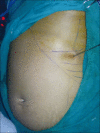Veress needle insertion through left lower intercostal space for creating pneumoperitoneum: Experience with 75 cases
- PMID: 22837595
- PMCID: PMC3401722
- DOI: 10.4103/0972-9941.97590
Veress needle insertion through left lower intercostal space for creating pneumoperitoneum: Experience with 75 cases
Abstract
Context: Veress needle insertion (VNI) at sub-umbilical fold (SUF) midline is associated with serious intra-abdominal injuries.
Aim: The aim of this study has been to evaluate the safety and efficacy of lower left intercostal space (LICS) for VNI.
Settings and design: This prospective observational study was conducted in three parts in Surgery-II, Department of Surgery, GTBH-UCMS, Delhi.
Materials and methods: In part one, skin fold thickness (SFT) was measured in 32 patients at SUF, LICS, right iliac fossa (RIF) and Palmer's point. As part two, in these patients, VNI was carried out from LICS under laparoscopic guidance. As part three, same technique of VNI was employed in 43 patients with suspected intra-abdominal adhesions undergoing laparoscopy for various reasons. Observations were made regarding ease of insertion, attempts needed for successful entry, loudness or clarity of give-way feeling of Veress needle, intra-abdominal bleeding at point of emergence of Veress needle, hemopneumothorax, bowel or vascular injury.
Statistical analysis used: SFT was expressed as mean (SD), and one-way ANOVA followed by Tukey's test were employed to find the statistical significance.
Results: SFT at LICS was significantly less as compared to SUF and Palmer's point. VNI at LICS was easy to carry out; it could be successfully done in first attempt in all patients, and was associated with very clear and loud give-way feeling. There were no instances of intra-abdominal bleeding at point of emergence of Veress needle, hemopneumothorax, bowel or vascular injury.
Conclusions: VNI at LICS as described here is safe and effective.
Keywords: Abdominal entry; laparoscopy; veress needle insertion.
Conflict of interest statement
Figures
Similar articles
-
Laparoscopic entry: a review of techniques, technologies, and complications.J Obstet Gynaecol Can. 2007 May;29(5):433-447. doi: 10.1016/S1701-2163(16)35496-2. J Obstet Gynaecol Can. 2007. PMID: 17493376 Review. English, French.
-
Latif's point: A new point for Veress needle insertion for pneumoperitoneum in difficult laparoscopy.Asian J Endosc Surg. 2018 May;11(2):133-137. doi: 10.1111/ases.12418. Epub 2017 Aug 30. Asian J Endosc Surg. 2018. PMID: 28856845
-
Comparison of Veress needle and direct trocar technique during laparoscopic initial entry via Palmer's point.Ceska Gynekol. 2024;89(6):451-458. doi: 10.48095/cccg2024451. Ceska Gynekol. 2024. PMID: 39800541 English.
-
[Risks associated with laparoscopic entry].J Gynecol Obstet Biol Reprod (Paris). 2010 Dec;39(8 Suppl 2):S123-35. doi: 10.1016/S0368-2315(10)70039-9. J Gynecol Obstet Biol Reprod (Paris). 2010. PMID: 21185465 French.
-
Access techniques: Veress needle--initial blind trocar insertion versus open laparoscopy with the Hasson trocar.Endosc Surg Allied Technol. 1995 Feb;3(1):35-8. Endosc Surg Allied Technol. 1995. PMID: 7757437 Review.
Cited by
-
Influence of 2 Veress needles and 4 insertion sites on Veress needle penetration depth: A comparative study in cadaveric dogs.Vet Surg. 2018 Nov;47(8):1094-1100. doi: 10.1111/vsu.12956. Epub 2018 Sep 23. Vet Surg. 2018. PMID: 30246303 Free PMC article.
-
Jain point: A new safe portal for laparoscopic entry in previous surgery cases.J Hum Reprod Sci. 2016 Jan-Mar;9(1):9-17. doi: 10.4103/0974-1208.178637. J Hum Reprod Sci. 2016. PMID: 27110072 Free PMC article.
References
-
- Santala M, Jarvela I, Kauppila A. Transfundal insertion of a Veress needle in laparoscopy of obese patients: a practical approach. Hum Reprod. 1999;14:2277–8. - PubMed
-
- Ahmad G, Duffy JM, Phillips K, Watson A. Laparoscopic entry techniques. Cochrane Database Syst Rev. 2008;16:CD006583. - PubMed
-
- Vilos GA, Ternamian A, Dempster J, Laberge PY. The Society of Obstetricians and Gynaecologists of Canada. Laparoscopic entry: A review of techniques, technologies, and complications. J Obstet Gynecol Can. 2007;29:433–65. - PubMed
LinkOut - more resources
Full Text Sources
Molecular Biology Databases
Research Materials


